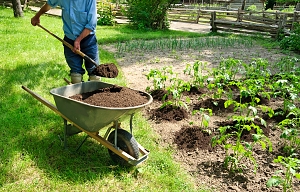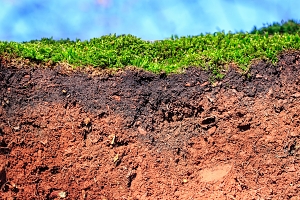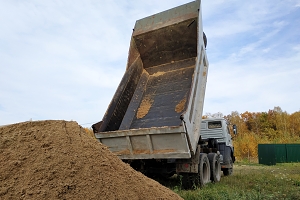Dirt, often perceived as a simple and mundane entity, holds a complexity that surpasses our common understanding. While we are all acquainted with its various uses, there exists a realm of information about dirt, its composition, and its genesis that might surprise you.
Delving into the World of Dirt: 10 Intriguing Facts
1. Topsoil Formation
 The outermost layer of soil, known as topsoil, is a reservoir of nutrients, gases, and bacteria essential for supporting vegetation. Astonishingly, it takes up to 500 years to produce a mere inch of this vital layer. The process involves the breakdown of dirt due to the decomposition of organic matter, combined with moisture and natural elements, highlighting the extensive time span required for its creation.
The outermost layer of soil, known as topsoil, is a reservoir of nutrients, gases, and bacteria essential for supporting vegetation. Astonishingly, it takes up to 500 years to produce a mere inch of this vital layer. The process involves the breakdown of dirt due to the decomposition of organic matter, combined with moisture and natural elements, highlighting the extensive time span required for its creation.
2. Carbon Dioxide Storage
The role of soil in carbon dioxide storage emerges as a crucial element in the intricate dance of environmental sustainability. Accounting for approximately 10% of the world’s total carbon dioxide, soil stands as a formidable reservoir for this greenhouse gas. This seemingly unassuming layer of the Earth plays a dynamic role in mitigating the impact of CO2 emissions on our planet.
Soil as a Sentinel
Acting as a vigilant sentinel, soil serves as a natural filter to groundwater, orchestrating a process that extends beyond its surface. When carbon dioxide is released into the atmosphere through various human activities, such as the burning of fossil fuels and deforestation, the soil acts as a dynamic buffer, intercepting and absorbing a substantial portion of these emissions.
Groundwater Guardian
Beyond its capacity to retain carbon dioxide, soil functions as a guardian to groundwater. The absorbed carbon dioxide undergoes a transformative journey within the soil profile, where microbial activity, chemical interactions, and physical processes come into play.
This intricate dance ensures that the carbon dioxide is not only captured but also undergoes processes that may render it less harmful, offering a dual-layered defense mechanism against the adverse effects of excessive greenhouse gas concentrations.
Regulating the Carbon Cycle
Soil’s role in carbon dioxide storage is intricately linked to the global carbon cycle. By retaining a significant portion of emitted carbon dioxide, soil contributes to regulating the delicate balance of this essential cycle. This, in turn, influences climate patterns, making soil an integral player in the broader environmental symphony.
3. Foundation of the Food Chain
Delving into the intricate web of ecological relationships, soil emerges as not just a passive layer beneath our feet but as the foundational bedrock of the Earth’s elaborate food chain. Positioned at the base of this intricate hierarchy, soil plays a pivotal role in sustaining life and facilitating the transfer of energy through various trophic levels.
The soil, acting as the hub of this intricate system, becomes the source of sustenance for a myriad of organisms. From insects and small invertebrates that directly feed on organic material to larger creatures that prey on them, the soil sets the stage for a cascade of interconnected relationships. This biological drama extends beyond the confines of the soil itself, influencing the health and diversity of plant and animal communities.
Recognizing soil as the foundation of the food chain underscores its crucial role in supporting not just natural ecosystems but also human societies. Agricultural systems, the backbone of human sustenance, depend on fertile soil to cultivate crops and raise livestock. Understanding the delicate balance within the soil ecosystem becomes imperative for sustainable land management practices and food security.
4. Microorganism Abundance
Within the confines of a seemingly unassuming handful of soil lies a thriving microscopic universe, a bustling community of microorganisms that holds the key to the health and vitality of our terrestrial ecosystems. The sheer abundance and diversity of these tiny life forms are nothing short of astounding, surpassing the global human population.
Unveiling the intricate world of microorganisms in soil unveils their pivotal role in the creation and maintenance of topsoil, contributing indispensably to the processes of breakdown and decomposition crucial for soil health.
Unseen Architects
 In the hidden recesses of soil, billions upon billions of microorganisms labor tirelessly, undertaking the vital task of breaking down organic matter. These unseen architects include bacteria, fungi, protozoa, and other microbial entities, each playing a unique role in the intricate web of soil life. Their collective efforts result in the transformation of raw organic materials into the rich, nutrient-laden topsoil that sustains plant life.
In the hidden recesses of soil, billions upon billions of microorganisms labor tirelessly, undertaking the vital task of breaking down organic matter. These unseen architects include bacteria, fungi, protozoa, and other microbial entities, each playing a unique role in the intricate web of soil life. Their collective efforts result in the transformation of raw organic materials into the rich, nutrient-laden topsoil that sustains plant life.
Decomposition Symphony
Microorganisms orchestrate a symphony of decomposition, breaking down complex organic compounds into simpler forms. This process not only releases essential nutrients into the soil but also facilitates the recycling of organic matter. Dead plant and animal material, once decomposed by these microscopic agents, contribute to the organic matrix that forms the basis of fertile topsoil.
Nutrient Cycling Maestros
Beyond their role in decomposition, microorganisms act as nutrient-cycling maestros. They mediate the transfer of nutrients between soil and plants, enhancing the availability of vital elements like nitrogen, phosphorus, and potassium. This nutrient exchange is fundamental to the sustenance of plant life and, by extension, the entire food web.
5. Living Ecosystem
Soil is a living system in itself. Microorganisms feed on each other, and earthworms move through the soil, releasing waste and contributing to its health. The interplay of sun, moisture, and various components creates a self-sustaining ecosystem within the soil, forming a world within a world.
6. Environmental Threat
Soil erosion stands as the second-largest environmental issue after population growth. Overfarming and development contribute to the loss of soil, posing a potential threat with long-lasting consequences. The regeneration of topsoil is outpaced by the rate of erosion, raising concerns for the future.
7. Bacterial Contribution
Contrary to common belief, bacteria is a crucial component for maintaining healthy soil. It facilitates the breakdown and decomposition processes, turning ordinary dirt into nutrient-rich topsoil.
8. Dirt vs. Soil
While dirt is the raw material before the breakdown, soil is the byproduct of chemical and structural changes in dirt. Fill dirt, found below topsoil, remains stable and is used for construction purposes.
9. Earthworm Abundance
An acre of cropland can host 1.4 million earthworms. These diligent creatures play a vital role in creating usable soil, multiplying rapidly and contributing to the overall health of farmland.
10. Earthworm Productivity
A single earthworm can pass 15 tons of dry soil through its system in a year. This continuous process of soil consumption and excretion by earthworms enhances soil quality, making them essential contributors to soil health.
Reach Out to the Northern Virginia Dirt Experts
 Dirt, in its various forms, is an integral part of our ecosystem. As we uncover these fascinating facts, it becomes apparent that our relationship with dirt goes beyond surface-level awareness. Whether it’s the slow formation of topsoil or the intricate interactions within the soil ecosystem, acknowledging the significance of dirt enriches our understanding of the natural world.
Dirt, in its various forms, is an integral part of our ecosystem. As we uncover these fascinating facts, it becomes apparent that our relationship with dirt goes beyond surface-level awareness. Whether it’s the slow formation of topsoil or the intricate interactions within the soil ecosystem, acknowledging the significance of dirt enriches our understanding of the natural world.
If you find yourself in need of dirt for construction projects, rely on Dirt Connections for professional residential dirt grading assistance, reliable dirt delivery, and comprehensive site work. With our knowledge and experience, we ensure your property receives the necessary elements for any task at hand.









































